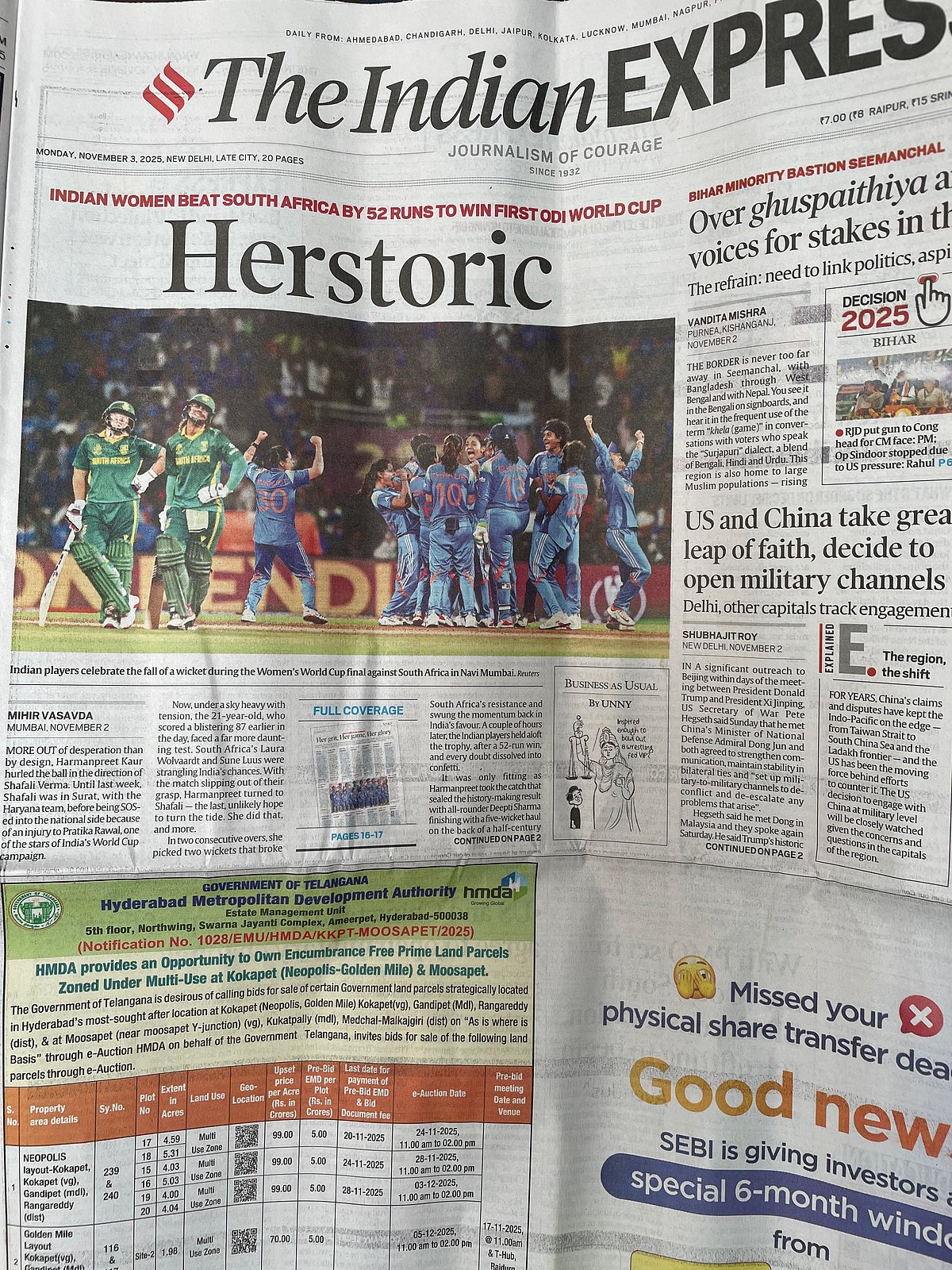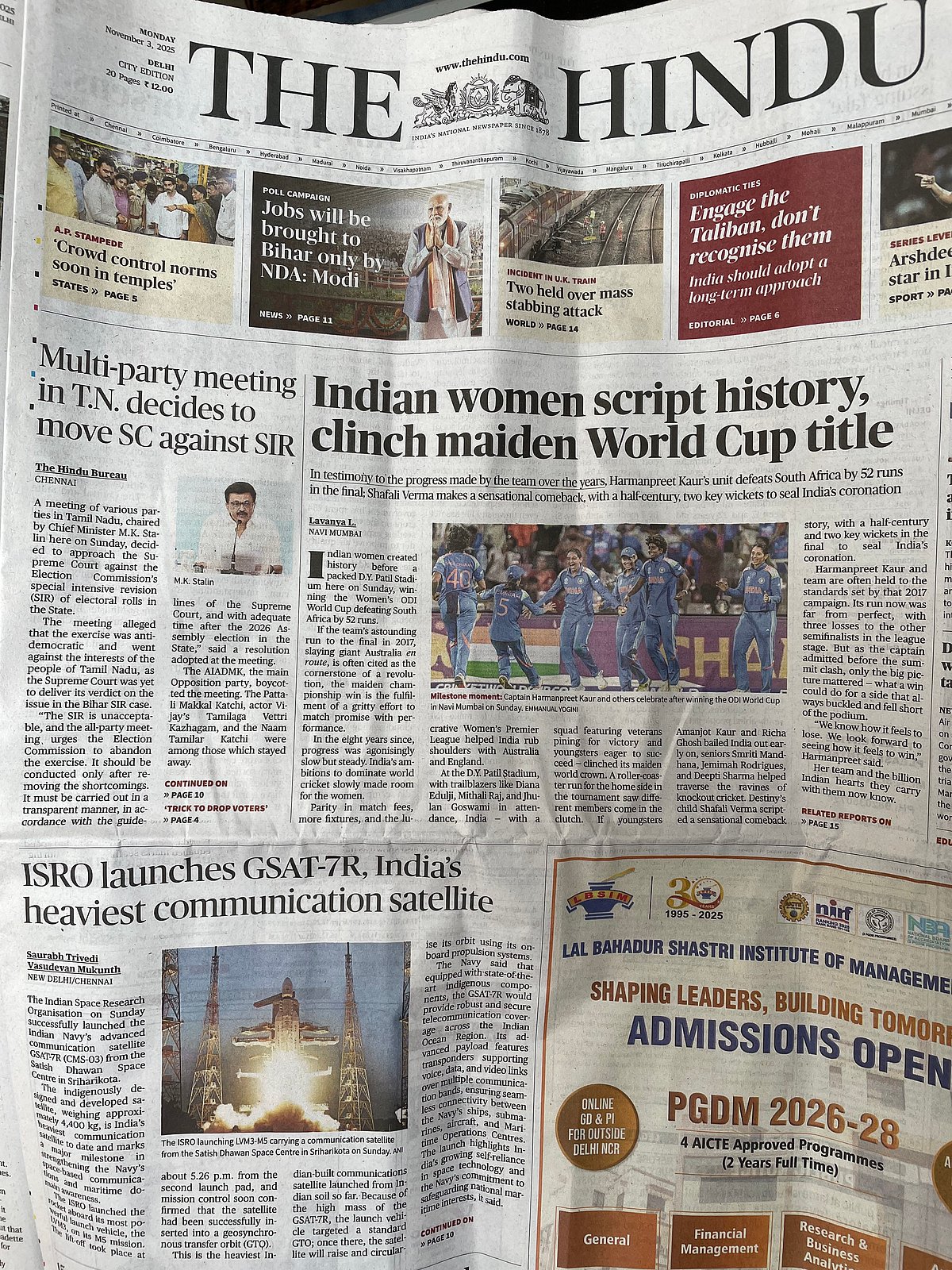‘Her cup, her story’: Indian cricket is now complete as women’s cricket rewrites the headlines
India defeated South Africa by 52 runs to win their first-ever ICC Women’s World Cup.
“Herstoric.” “Indomitable India.” “A giant leap: It’s her cup.”
After the story of India’s first Women’s World Cup win unfolded under the floodlights of Mumbai’s DY Patil Stadium, it played out again the next morning across the front pages of the country’s biggest newspapers. Photographs of the Indian women’s cricket team – arms aloft, confetti in the air – displaced Bihar elections, markets and everything else.
India had defeated South Africa by 52 runs to win their first-ever ICC Women’s World Cup. The victory, four decades after the men’s 1983 triumph, was hailed by many as a turning point that “completes Indian cricket”. BCCI secretary Devajit Saikia announced a Rs 51 crore reward for the players and support staff.
Batting first, India posted a commanding 298/7, powered by Shafali Verma’s 87, Deepti Sharma’s 58, and a 100-run opening stand between Smriti Mandhana and Verma. South Africa began the chase steadily before Amanjot Kaur’s direct hit and Sree Charani’s breakthrough shifted the momentum. Deepti Sharma then completed a dream performance with 5 for 39, crushing South Africa’s middle order. Despite Laura Wolvaardt’s fighting 101, the Proteas folded for 246, handing India a famous 52-run win amid deafening home support.
It was the culmination of a decades-long pursuit. India had reached the final in 2005, 2017 and again in 2025, only to fall heartbreakingly short. This time, they didn’t.

“Herstoric,” said the lead headline on The Indian Express front page.
When the team defeated Australia in a 300-plus chase before the final, an editorial in The Indian Express had last week noted that it should silence the team’s detractors. “In a historic chase of 339 — the highest in women’s cricket — India broke the 15-win streak of the Aussie women’s team at ODI World Cups, which included an unbeaten road to the 2022 world title. India had never previously chased down even 200 in a World Cup knockout. But the team went on to etch memories that will last a lifetime for followers, many of whom rejoiced after watching Jemimah Rodrigues, Harmanpreet Kaur, and later Richa Ghosh and Amanjot Kaur, pull off a major upset.”
A piece after the final victory noted how the dream has now been lived. “Bollywood has scripted fictional narratives where women had to dress up as men to simply play good cricket. The movie Chak de! India dreamt up a scenario where an Indian team defeated Australia in a hockey final, and gave Indian sport its unofficial anthem. India’s women have now lived the dream, watched by doting billions and inspiring generations of women to aim for wins.”

The Hindu opted for the understated but emphatic “Indian women script history, clinch maiden World Cup title,” calling the triumph “a testimony” to the progress made by the team over the years.
Meanwhile, Hindustan Times led with “Indomitable India”, the team’s photograph dominating the page and pushing the Prime Minister’s Bihar remarks against the Mahagathbandhan to a second lead space.

The Times of India chose celebration with the lead headline: “Windia! Harman’s heroes make herstory.” The front flaps carried congratulatory brand ads riding the national cheer.
The victory also made it to the front page of Hindi dailies.

The Telegraph’s front page headline declared it was “A giant leap: It’s her cup”. Its report traced how India’s talent pool deepened after 2017 and how the team learned from heartbreaks in 2020 and 2023 to finally prevail at home. “After this Cup success,” it concluded, “Indian cricket won’t just be about the Kapil Devs, Gavaskars, Tendulkars, or Kohlis. The Harmanpreets, Smritis, and Deeptis will now share that pedestal. And the onus of carrying Indian cricket’s dreams will no longer rest solely on the men.”
A piece in the paper had earlier noted how the vocabulary of “the gentleman”s game” has always been stubbornly male. Words like maiden over, third man and nightwatchman were designed in an era that didn’t imagine women would play, it had noted. In 2021, the MCC finally modernised its laws, replacing “batsman” with “batter”.
A linguistic shift that hinted at a broader rewriting now made real on the field.
Complaining about the media is easy. Why not do something to make it better? Support independent media and subscribe to Newslaundry today.
